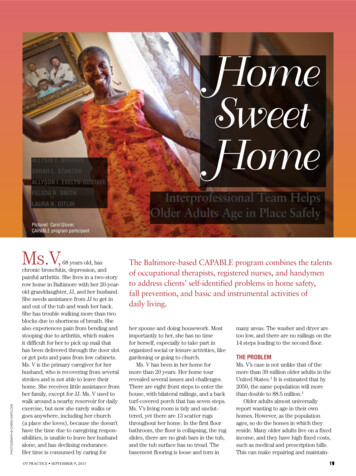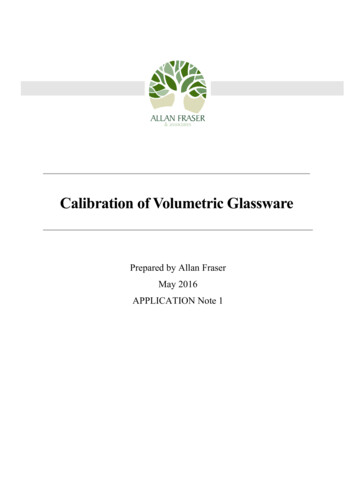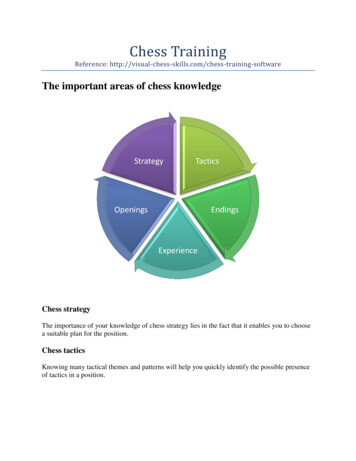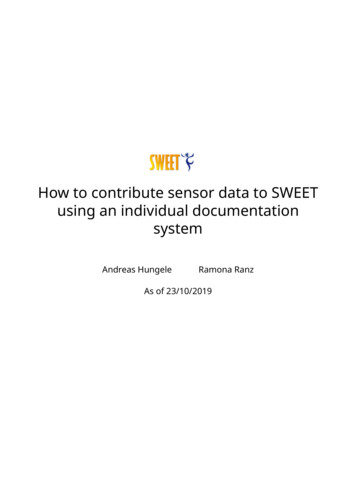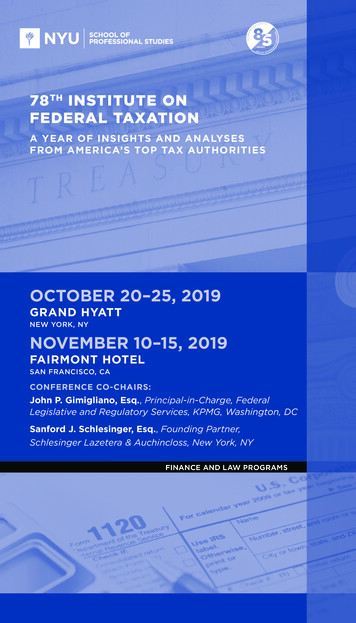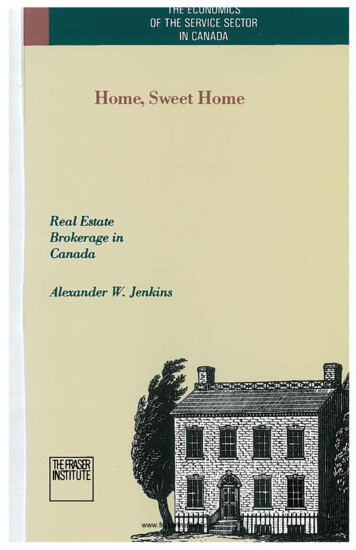
Transcription
Home, Sweet HomeReal EstateBrokerage inCanadaAlexander W. Jenkinsll FRASERINSTITUTEwww.fraserinstitute.org
THE ECONOMICSOF TRE SERVICE SECTORIN CANADASeries Editors:G. GrubelMichael A. WalkerHerbertwww.fraserinstitute.org
lIonrre, S eetlIonrreReal EstateBrokerage inCanadaAlexanderW. Jenkinsllf ffiI\SERINSTITUTEwww.fraserinstitute.org
This study is part of a general programme of research into the services sector madepossible by a contribution from theDepartment of Regional Industrial Expansion,.Government of Canada.The author of this book has worked independently and opinions expressed by him,therefore, are his own and do not necessarily reflect the opinions of the members orthe Board of Trustees of The Fraser Institute.Canadian Catalogning in Pnblication DataJenkins, Alexander William, 1946Home, sweet home: real estate brokerage in Canada(The Economics of the service sector in Canada,ISSN 0835-4227)Bibliography: p.ISBN 0-88975-124-21. Real estate business - Canada. I. Fraser Institute(Vancouver, B.C.). II. Title. III. SeriesHD316.J45 1988333.33'0971C88-091609-5Copyright 1989 by The Fraser Institute. All rights reserved. No part ofthis book may be reproduced in any manner whatsoever without writtenpermission except in the case of brief quotations embodied in critical ar ticles and reviews.Printed in Singapore.www.fraserinstitute.org
CONTENTSPreface I ixAcknowledgements I xiiiAbout the Author I xvCHAPTER 1THE CANADIAN REAL ESTATE BROKERAGE INDUSTRY 11Introduction 11Background 13Government Policy Recommendations I 5Concluding Remarks I 6CHAPTER 2AN OVERVIEW OF THE CANADIAN REAL ESTATEBROKERAGE INDUSTRY 17Industry and Service Definitions 17General Industry Description 18Service Characteristics /8Historic Evolution ofService Characteristics / 11Main Consumers / 13Employee Characteristics / 13Research and Technology / 15Role of Government / 16Industry Associations / 17Government Statistics / 18Regional Differences in Production / 20Importance ofImports and Exports /20Industrial Organization 123Ownership Types / 23Size Distribution ofFirms / 23Franchising /25Foreign Ownership /26The Information Revolution 126Notes 129www.fraserinstitute.org
viContentsCHAPTER 3INDUSTRY OUTPUT: LEVELS, DESTINATION, ANDINTERDEPENDENCIES /31Level of Production and Sales /31Composition of Sales / 34Re gional Distribution of Output /3 5Seasonality /36Notes /38CHAPTER 4INDUSTRY EMPLOYMENT AND PRODUCTIVITY:LEVELS AND TRENDS / 39Expenditures on Inputs /39Labour Intensity /41Intermediate Material Inputs /42Intermediate Service Inputs /42Capital Inputs /43Licensing and Franchise Fees /43Profits /44Prices and Performance of Services Sold /44Characteristics of the Labour Force / 45Number ofEmployees /45Unionization /48Training Facilities /48The Role of the Entrepreneur /49Coverage by Statistical Surveys /49Productivity of the Labour Force / 50Notes / 56CHAPTER 5SOURCES OF CHANGING DEMAND FOR REAL ESTATEBROKERAGE / 59Growth of the Owned Housing Stock / 59Increasing Turnover of Owner Housing / 59Substitution of Brokerage for Sale-by-Owner Methods / 60Real Mortgage Interest Rates and Real Housing Prices / 62www.fraserinstitute.org
ContentsviiRegression Analysis /62Notes /66CHAPTER 6WELFARE AND INCOME DISTRIBUTION EFFECTS /67Employment /67Value Added /68Earnings Distribution /68Profitability /70Industry Variability /72Notes /74CHAPTER 7MAJOR ISSUES AND GOVERNMENT POLICY /75Competition and Efficiency /7 5Access to the MLS /79Regulation /81Packaging of Real Estate Brokerage and Mortgage Services /83Summary of Major Policy Recommendations /85Mergers /85Franchises /85MLS /86Regulation. Deregulation. and Self-Regulation /86Service Packaging /87Consumer Education /87Notes /89Appendix: Agency and Dealer Markets for Houses and Cars /91References /97www.fraserinstitute.org
Tables and FiguresTable1Summary of Total MLS Activity: Canada 1956-86/21-222Residential MLS for Canada, Unit Sales/353Average Monthly MLS Sales, Percent of Yearly Total, 1980-85 Average/364Nominal and Real Commissions per MLS Sale/455MLS Unit Sales and CREA Membership/526Estimated MLS and Total Residential Unit Sales/537Estimated MLS and Total Broker Sales/538CREA Members and FfME Salespersons/549Broker Sales per FfME Salesperson/5410Annual Growth Rates, Selected Variables/6411Average Annual Profitability, Selected Industry Groupings, 1974-84/7112Average Annual Output Growth Rates,1971-85/72Figure1Exclusive Listing Service/82Multiple Listing Service/83Intercensal Growth Rates/334Annual Growth Rate Averages, 1971-81/335Output Indices/346Seasonality of Sales/377Reported Composition of Brokerage Costs/398Reported Composition of Company Dollar/409Estimated Factor Shares of Brokerage Output/4110Composition of Real Estate Brokerage Employment/4611Real Estate Salespersons Relative Earnings Indices, 1970 andwww.fraserinstitute.org1980/51
PREFACEReal estate brokerage is primarily a consumer service, and yet most of uswill deal with a real estate agent only a few times during our lifetimes.Even though homeowners are moving two or three times as often in the1980s as they did during the 1960s and 1970s, only about 5 percent changeresidence in any particular year. Partly because of our inexperience, mostof us choose to employ the services of real estate agents in buying and sell ing our properties. When we sell, we typically remit a widely adopted "for mula" commission: 6 percent in eastern Canada, and, in western Canada, 7percent plus 3 percent on any house value in excess of 100,000. Sincethese outlays are substantial, all of us, as homeowners, agents, policymakers and advisers, and researchers, might benefit from the better under standing of real estate brokerage that is purposed by this study.Because homeowners change residences so infrequently, they are oftenunfamiliar with property appraisal, advertising, negotiating, and otherdimensions of property resale and transfer. As a result, roughly 90 percentengage a real estate agent, and of these, about four out of five transactthrough the Multiple Listing Service, or MLS, particularly in slowermarkets. In return, home sellers receive a higher gross price (by roughly 3percent), but a lower net price (by about 3 percent); buyers receive a better"match"; and both reduce personal time, psychic, out-of-pocket, and othersearch and transactions costs. To the extent that the real estate brokeragemarket is genuinely competitive, society as a whole realizes a large welfaresurplus from the resulting efficient resale housing market.The output and employment of real estate brokerage have grown morethan twice as fast as the rest of the economy during the past two decades.Increasing rates of property turnover are the main explanation for thisgrowth. These are in turn the consequences of greater geographic mobility,partly due to company and state moving subsidies; upward filtration fromstarter to executive homes by baby-boomers during an era of high housingprices and mortgage interest rates; and even recent capital gains tax exemp tions. Given the increasing size and complexity of urban housing markets,as well as moving subsidies, it is not surprising that homeowners generallyutilize real estate agents, particularly those accessing the computerized, in formationally efficient MLS system. Only the Atlantic provinces, Quebec,and the northern territories have failed thus far to exhibit well-developedreal estate brokerage markets-but even these should catch up to the rest ofCanada by the late 1990s.Largely due to the computerization of the MLS during the late 1970s andearly 1980s, real estate salesperson productivity has grown by about one-www.fraserinstitute.org
xPrefacethird over the past decade-over twice as fast as productivity growth in therest of the economy. However, productivity still seems rather low to acasual observer-only four or five properties sold annually per full-timesalesperson. Moreover, it seems that only a minority of this productivitygrowth appears to have been passed on to consumers in the form of loweraverage commission rates or faster sales for home sellers. Indeed, thesecular rigidity of the commission-rate formula implies no readilymeasured decline in the real price of brokerage services in eastern Canada.In western Canada, the secular growth of some housing prices above 100,000 implies a corresponding decline in average commission rates(from roughly 7 to 6 percent), but this decline has been proportionately lessthan the increase in productivity (about one-seventh compared to one third). As a result, brokers, rather than consumers, appear to have ap propriated most of the productivity gain in the shortrun. This is conceivablythe result of the less than complete evolution of competition among brokerssince the "decartelization" of the industry in 1976. Easy entry conditions,together with rigid commission rates, may have inhibited in the past, andmay erode in the future, that part of productivity gains reflected in higherthan normal earnings for salespersons.Prior to 1976, the Canadian real estate brokerage industry was organizedas a cartel, with the local real estate boards fixing the commission rates forits members at the formula levels still widely observed in today's markets.Members who discounted could be expelled and lose listing access to theMLS. In 1976, the real estate brokerage and other service industries be came subject to federal competition laws, and so formal price fixing be came illegal. However, unlike the securities industry's commission ratestructure after deregulation, real estate brokerage commission rates havegenerally remained at formula levels. Real or average commission ratelevels therefore appear to have persisted in eastern Canada, while they haveonly declined in western Canada due to the secular inflation of some hous ing prices beyond 100,000; for example, 7 (5) (4) percent on a housevalued at 100,000 ( 200,000) ( 400,000). Not surprisingly, real estatebrokerage profit rates have remained at levels two or three times those forthe rest of the economy, in spite of growing levels of costly mass-media, or"brand," advertising.Commission-formula rigidity, and the corresponding negligibility of anydeclines in average commission rates, may reflect an insufficiency of com petitive behaviour, in spite of the intended decartelization of 1976. Onepossible "structural" deterrent to competition is the high and rising levels ofindustry concentration that occurred in the early 1980s, primarily throughlarge brokerage mergers such as that between AE. LePage and RoyalTrust. The recent growth of franchises, such as RejMax and Century 21, istheoretically more conducive to competition, but it may have done" littlemore than create competition in the market for top salespersons. This is bewww.fraserinstitute.org
Prefacexicause franchises typically offer salespersons retention of about 95 percent,rather than the traditional 50 percent, of their commissions. Perhaps in thelong term, the full-commission franchises might provide a further stimulusto more widespread discounting of real estate brokerage commissions.Another contributor to commission-formula rigidity may be the "openpricing" policy of the MLS, whereby catalogues publish listing-agent com mission rates and selling broker identities. Other possible causes are therecently alleged restrictions on commission-rate advertising at the retaillevel imposed by at least one local board, and local boards' denying accessby discount brokers to computerized listing services.Public policy recommendations are several. Federal competitionauthorities should continue to scrutinize carefully large broker mergers,possible conspiracy and open pricing within the MLS, advertising restric tions, and any predatory or misleading aspects of recent packaging of realestate brokerage and mortgage services. To the extent that the MLS is anatural monopoly, provincial governments should consider legislating an"open" MLS on a trial basis. Home sellers and buyers, wishing to sell andbuy privately ("sale by owner"), would then have direct, cost-based accessto the MLS, and henceforth a low-cost and effective alternative to transact ing through brokers.Provincial governments should also refuse to introduce or sanction anyrestrictions on the supply of real estate agents, including quotas and theundue escalation of educational standards. They should also prohibit anyrestrictions on part-time employment, and resist any undue demands for su pervision quotas, e.g., one full-time manager per office, for full-commis sion companies. They should also ensure that self-regulating brokerassociations are ultimately accountable to provincial legislatures.Finally, both federal and provincial governments should become moreinvolved in educating consumers about the nature of real estate brokerageand property resale in general. They could publish brochures highlightingthe feasibility of sales by owner, with or without an open MLS; the accessto all brokers gained through an MLS listing, even if transacted through asmall broker with low listing commission rates; and the feasibility ofnegotiating reductions in commission rates, especially the rate paid to thelisting broker. Together with competitive brokerage markets, consumer in formation would do much to generate more efficient brokerage and resalehousing markets.www.fraserinstitute.org
www.fraserinstitute.org
ACKNOWLEDGEMENTSIn addition to funding and technical assistance, I would like to thank theDepartment of Regional Industrial Expansion and Statistics Canada forsponsoring the workshops which formed part of the services study. At theFraser Institute, both Executive Director Michael Walker and the Directorof the Service Industries Project, Herbert Grubel, provided valuableguidance on the scope and format of the study; as well, there were helpfulsuggestions from anonymous referees.Numerous organizations and their representatives gave assistance in d
Home, Sweet Home Real Estate Brokerage in Canada Alexander W. Jenkins ll FRASER INSTITUTE www.fraserinstitute.org. THE ECONOMICS OF TRE SERVICE SECTOR IN CANADA Series Editors: Herbert G. Grubel Michael A. Walker www.fraserinstitute.org. lIonrre,S eetlIonrre Real Estate Brokerage in Canada Alexander W. Jenkins llf ffiI\SER INSTITUTE www.fraserinstitute.org. This study is part of a


